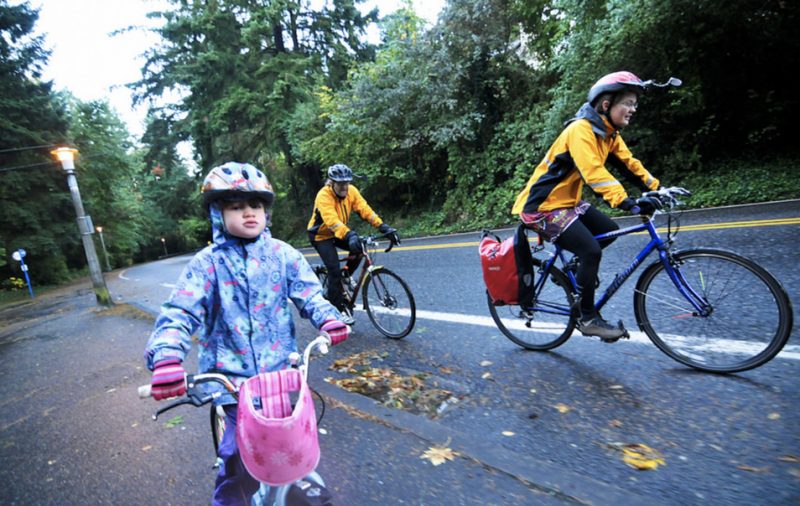
(Photo: J. Maus)
A few weeks ago I wanted to know what prevents you from biking with your young children. I got a lot of feedback. Several themes emerged, the most prevalent of which, surprised me.
Strangely enough, one of the comments that stuck with me most was left by reader John Liu on a subsequent post. He wrote:
Rule 1: no matter the topic of the post, the comments are always about infrastructure.
I’d been lulled into complacency by the comparative awesomeness (compared to most the rest of the US, that is) of Portland’s bike infrastructure. I figured everyone was making-do and appreciative of what we have here, despite the obvious shortcomings. But apparently that’s my new-in-town, still-fresh-faced-and-rosy-cheeked bias showing. Turns out many of you are worried about infrastructure that does not make streets safe enough for you and your family.
But that’s not the only thing we heard. Here’s what else weighs on the minds of moms, dads, and the caregivers of Portland (as culled from our blog, Facebook, Instagram, and Twitter posts)…
Infrastructure
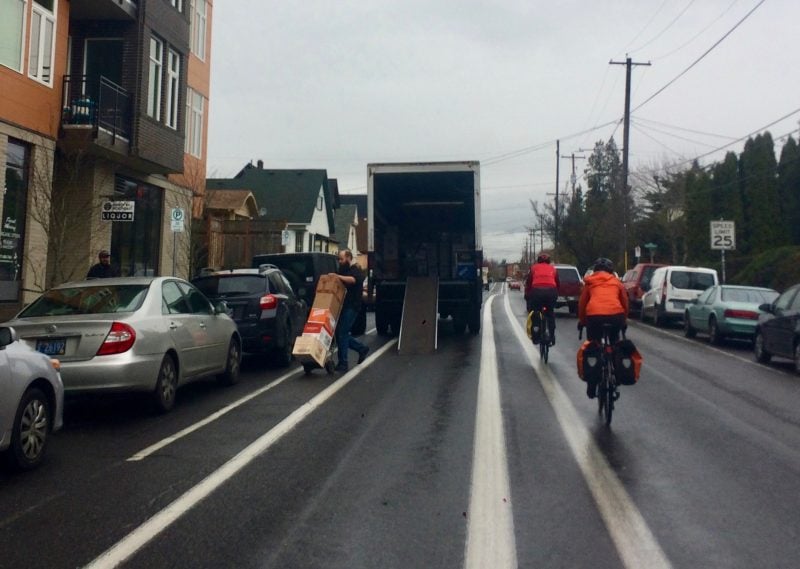
(Photo: Madi Carlson)
Here are two snippets of a comment from Clint Culpepper that particularly spoke to me:
The gaps in our network appear magically once a kid is with you…He’s physically capable of riding the distance to and from his preschool but downtown is a no-go.
A lot of people shared that like me, they make changes to their bike routes to make them safe for kids, but there are some places that simply don’t allow for that.
From johnny burrell:
It comes down to safety. The bike lanes around town are OK for me, but with my 2 kids it’s too hard to find safe routes. The city has grown and NE PDX has become incredibly dense, but our bicycle infrastructure hasn’t grown to keep up. A perfect example is Vancouver/Williams. Very few kids ride bikes on two of Portland’s main cycling thoroughfares because it simply isn’t safe.
Too true! The thing I like about paint-buffered bike lanes is at least the right amount of space has been allocated to bikes and adding a real barrier should be that much easier. Car parking and bike lane would need their positions swapped, but there’d be no loss of parking spots (not that I think a loss of parking spots is a bad thing, but I’m biased).
Advertisement
Weather
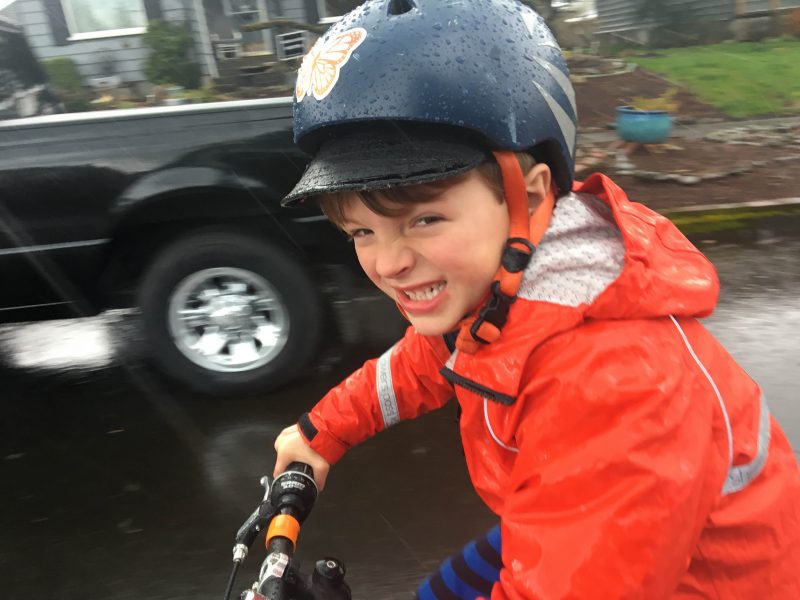
(Photo: J. Maus)
From Tad Reeves via Twitter:
For me, it’s mostly weather. We have a WeeHoo and a Burley Honey Bee for the little one and bikes for the biggers. But rain pants are spensive as hell, esp when you have to get them for growing kids.
and from “just one skip remount”:
The rain is the only thing that holds my fam back. Not the traffic, the hills or the infrastructure. Just that rain. Without shame, I look forward to the sun shine!
As a native Southern Californian, I find Pacific Northwesterners to be amazingly hardy! But even so, I’m not alone in saying I’d much rather bike in nice weather than bad, and I would never fault anyone for complaining about (or avoiding completely) biking in the rain. The happier the kid(s), the happier the commute, the happier the parent. And it’s not as easy to keep kids — especially in passenger form — happy in the rain. Passengers are going to notice uncomfortable rain in their faces more than pedalers and they get cold much more easily. And as Tad mentions above, rain pants aren’t cheap.
Theft/space
…our apartment is small so we’d have to store it outside and there have been thefts from the racks in our area.
I don’t enjoy carrying a regular size and weight bike inside my house, but a family bike is just about impossible for me to maneuver anywhere tricky. Bikes take up space (I have no furniture in my living room so our bikes can live inside) and if they’re not easy to get to, we’re much less likely to use them. Locking bikes outside makes them easy to access but prone to theft. The theft of any bike is heartbreaking, but when it’s bike designed or modified to carry kids, it’s especially so. As for commenter Anna, fortunately she lives downtown without a car and can walk and take transit most places.
Judgment
When I talk to other parents, many cannot get past the fact that I bike with my kids in Portland when they perceive it’s not safe to bike with kids. The judgment and fear is real!
Ugh, the judgment of other parents!
I feel more exposed to judgment on my bike than I do to danger… I can’t roll up the car windows to hide from public scrutiny.
Impossible to ignore and easy to imagine even when nothing is said aloud. I feel more exposed to judgment on my bike than I do to danger. Once a woman in a minivan rolled down her window and drove beside me (I was in a bike lane with a one-foot, paint-only buffer) to tell one of my kids to stop hitting his brother. She drove alongside me for one long block, her attention on us rather than the road in front of her. I didn’t think she was going to accidentally run us over, but I was horrified at her lack of attention to driving. I didn’t feel safe to say this to her, though. Not because I didn’t want to cross a person operating a machine that could so easily crush us, but because she was so oblivious to her dangerous behavior I knew it wouldn’t register.
On my bike I feel obligated to narrate every little tantrum in cheery sing-song, “I hear that you’re hungry/I am, too!/We’ll be home in five minutes/We’ll eat some stew!” or “Why don’t we give a name to that worm you had to leave at the park? And we’ll go visit him again tomorrow,” lest anyone think the wailing is because of the biking and because I can’t roll up the car windows to hide from public scrutiny.
As more and more of us take to biking for transportation with kids, it will become more commonplace and less alarming for our car-bound peers. I doubt the same (and appropriate) fear will ever be cast upon putting precious kids into cars so I make a point of never arguing back with data, but focus only on the fun of biking with kids and how safe it feels to me.
Time
Time. I drop kids off at two different schools in Southeast and work downtown. Even employers who say they’re flexible and you can totally work from home if you need to: no. So the extra twenty minutes in the morning and evening make a difference.
Yep! In dense areas with adequate bike infrastructure, biking will always be faster than driving, but spread things out and that’s not the case. There are flexible workplaces out there and I’d like to think the tide is turning as I hear about companies offering compensation for walking, biking, and taking transit. This is another area in which I hope Portland will change exponentially and spur other cities to do the same.
ED’s comment hits on time as well as a bunch of other themes:
Honestly, it’s mostly momentum that keeps us from biking — it’s relatively easy to keep doing the same thing, which is driving. I gotta say it’s darn convenient having a warm, dry car that can quickly get us where we need to go, and quickly get us back home if an outing goes to pieces, and that we don’t need extra gear or clothing for.
Price
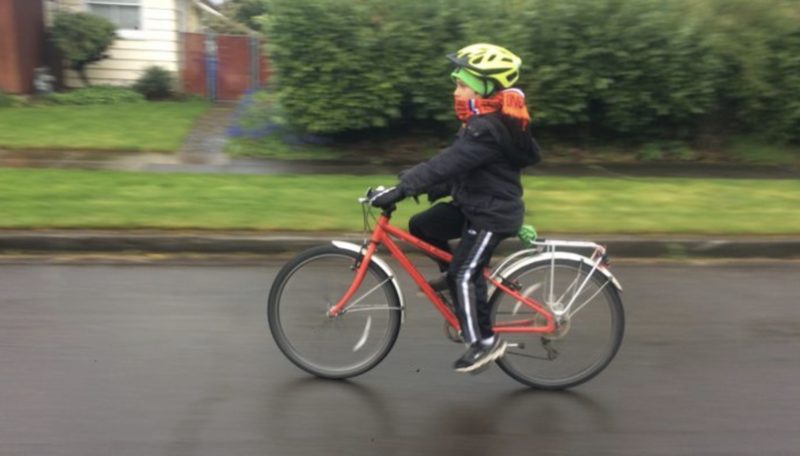
(Photo: Madi Carlson)
Also from ED’s comment:
Partly it’s steep learning curve and costs just for the first ride: we’d need to upgrade our bikes and/or buy a trailer for her, which seems like a big investment. I’m not sure how much biking would replace walking or driving for us.
I’m so impressed with families who trade minivan for cargo bike in the blink of an eye with no practice run. My transition to car-free was sooooooo slow and I didn’t invest in a cargo bike until we’d more than outgrown my little city bike with two kid seats. There are cheaper options out there, but even they are an investment and finding used items can require a lot of time for auction watching or the slow process of assembling all the necessary pieces gradually.
Gear that fits
Sara Davidson has been the Director of Kidical Mass for a long time (now Co-Director as I’ve joined leadership) and commented about gear:
I (obviously) have been a family biker for a long time, but on my own, I rarely do it anymore. Between an older kid who has an early school pickup, and younger one who really needs her naps at home, and series of longtail bikes that never quite fit, I’m mostly out. We take the whole family out on my husband’s long tail, but that’s a rarity in the cooler months.
I’m hardly a giant at 5’5″ but I’m tall enough that I can ride the smallest cargo bikes and have long realized that friends shorter than me were out of luck. Fortunately there are some cargo bikes that fit shorter people now, and in cities like Portland they’re even available at bike shops for test rides, but it’s still a lot harder for people not in the regular height range to find bikes.
Suggestions for improvement
I love that some readers included specific suggestions on what would make things better!
From maxD:
One of the biggest improvements PBOT could make is to complete the bike lanes on Skidmore between Michigan and 7th. This would connect destinations on North Killingsworth, Interstate, Mississippi, Williams, MLK and Alberta with a direct route that safely crosses I-5, Williams and MLK and provides dedicated space for bikes. The protected bike lanes on Skidmore from Interstate to Michigan are great- they are easy to use, they don’t rely on ambiguous rules or complicated routes; they just need to be extended. The alternative route, Going Greenway west of 7th, is the perfect example of what does not work for a kid. The route is literally incomprehensible (by me, at least), the crossing are super sketchy, and you wind up getting bullied by cars because you don’t have a dedicated space to ride/not enough sharrows and no stop bars.
And from Rider:
Diverters on every neighborhood greenway every four blocks are desperately needed.
I’ve heard this metric once before and I like it!
Are some of these barriers things you’ve overcome and can give advice about? These barriers all affect me to a certain extent. Weather, time, and infrastructure keep us close to home; but I expect our range will increase as the days lengthen — provided I can find safe routes. I predict I’ll discover a bunch of horrible gaps I hadn’t noticed when biking alone.
I agree that a lot needs to change to make our roads safer for everyone and I absolutely love the tireless work of advocacy groups like BikeLoudPDX and programs run by The Street Trust. Portland is definitely not resting on its laurels and I’m overjoyed to live in a city I think will continue to improve and inspire cities around the world.
Thanks for reading. Feel free ask questions in the comments below or email me your story ideas and insights at madidotcom [at] gmail [dot] com.
— Madi Carlson, @familyride on Instagram and Twitter
Browse past Family Biking posts here.
Get this and other BikePortland posts delivered directly to your inbox.
BikePortland needs your support.





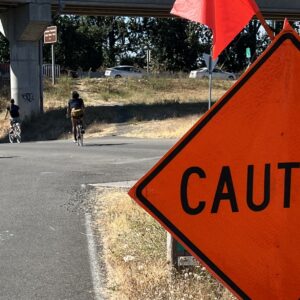

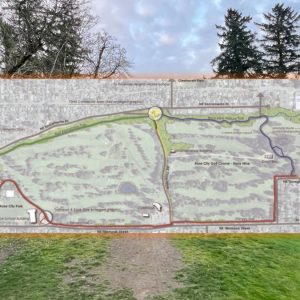
Thanks for reading.
BikePortland has served this community with independent community journalism since 2005. We rely on subscriptions from readers like you to survive. Your financial support is vital in keeping this valuable resource alive and well.
Please subscribe today to strengthen and expand our work.
Rain and safety. Two reasons Portland will never become a world class bicycling city.
What about small or big towns with sunny, mild climates?
Amsterdam and Copenhagen, world-class bike cities, have similar weather to Portland.
Portland rain is most often light and intermittent (we get about 50% less total rain, than, say, Atlanta — but ever hear anyone make jokes about Atlanta rain?)
I think the grey days (and total number of days with precipitation) play into the perception of it being rainy. And, as they say, perception can be reality. Hopefully we can retrain our brains and schedules to be patient, wait out the short heavy rain, and keep pedaling!
Evan, I agree with you, but found the average annual rainfall only about 5 inches more in Atlanta per my internet search, so definitely not 50% less rain here. I lived in Charlotte (similar climate to Atlanta) for a few years and the Summer heat, threat of lightning and horrendous infrastructure is definitely more restrictive than Portland’s weather.
There are very few safe spaces for kids to ride every day in Portland. I’m not sure I’ve ever seen a kid riding downtown, but look forward to seeing that this July at Sunday Parkways. Hopefully there people can start to envision the benefits of having separated infrastructure downtown and eventually a Green Loop that is accommodating to AAA (all ages and abilities).
Minneapolis has snow, yet people still bike, and arguably they are world-class. As pointed out above, Europe manages with the same weather we have, or worse. It’s not the weather so much as a lack of places at work to store and dry wet gear, and to change clothes.
This is the
This system seems to have mangled my quote quite a bit, I trust people reading it can figure it out.
Remember the pic of Sharky on his bike w/ his kiddo downtown? To me, that’s it. You either have the confidence in your abilities as a rider or ya dont. Nerfing the streets for bikes wont add to your abilities as a rider. Only the real world can boost your skills.
Thanks for giving me an excuse to delve into the BP photo archive and share those photos of Sharky and Velo circa 2006. ;-).
beautiful!
Cute, but very discouraging to even confident riders to suggest that you must have the skills to carry your 40lb kid on your back on a fixie. Dig the softside decorative helmet though, that looks like a nice lightweight way to ward-off the risk-shamers who don’t look closely enough to see if the helmet is actually effective.
Mine at 5yo had ridden on a saddle on the top-tube of my fixed-gear, but I would only ride like that rather slowly on forgiving infrastructure (or even more slowly on sidewalks.)
I look back fondly on the years I pedaled my small kids around on one of the first Xtra-cycles in Inner SE Portland. It was so much fun and, when the kids are very young, they are fairly passive passengers. It was easier to do a lot of bike commuting with them.
When they can ride their own bikes, the pace goes down and the anxiety for the parent goes way up. It’s very difficult to budget adequate time to bike commute with a youngster, especially in the rain.
When, at last, those kids are big and strong enough to bike on their own bikes with ease, they become lazy adolescents who want to sit on the couch and melt their brains with screens, hopefully to one day rediscover this 2-wheeled marvel!
“You either have the confidence in your abilities as a rider or ya dont.”
And if “ya dont”, then what? Should parents who bike with their kids be an exclusive club, populated by only the strongest and bravest of riders? (you know, those who are confident enough to give a kid a piggy back while riding fixed gear in the rain?)
All great journeys start with a single step. Get out there and develop your confidence and skills, dont hold your breath waiting on the for anyone else to provide it.
Or you can just do it, and figure it out as you go.
All of this is far easier if you don’t have a car to default back to.
This seems like a phenomenally unhelpful response to what many families express are major barriers for them to bike more with their kids.
The trouble with this subject is that feeling unsafe is subjective, and as others have pointed out, this feeling can be introduced by those who themselves have not biked, or reinforced by group-think. My point was that if one were to give it a try perhaps it wouldn’t turn out to be that difficult/scary/unpleasant.
Secondly, having a cozy car sitting in front of your house is a perverse incentive; I know it would weaken my resolve to stick it out, make it work, live down those who would have us believe that there are ten or a hundred reasons why the conditions for biking with kids are not adequate or good enough.
Here is where the electric assist comes in. With the motor, you’re less apt to fall back into driving because the hills are a big discouragement.
By that logic we need a motor to eschew a motor. Not sure that is such a sound prescription, given the circumstances.
Given that most people see no problem burning gasoline (emitting fossil carbon) to move their butt around with a 3000lb car, I’m not sure you should get so bent out of shape about using a small electric motor instead (with less than 1kWh in the battery i.e. an average day of solar energy collected by a 2x4ft panel.) Given the fixation on electric cars as a fantastical solution to climate change, getting people to accept electric bikes as an actually feasible solution would be a good start.)
I’m concerned about the capital invested in electric transportation today and tomorrow. By the time we’re ten percent there we may discover that we can’t afford even what you are suggesting is so benign. Someone has to take the long view, keep track of where and how all this power is to be generated, distributed. None of this is free or without environmental cost. Though Soren and I disagree about the error bars associated with human-powered transportation.
And while we argue about error bars, green house gas emissions are increasing again. I’ve pretty much given up hope that our society will do anything meaningful to address climate change.
I agree the response is unhelpful. Confidence is essential for both safety and fun — those who lack confidence are far more likely to make mistakes or react inappropriately in real world conditions.
Fear is your spidey sense’s way of telling you you’re not adequately equipped for the situation at hand. It’s important to develop skills at your own pace.
I’ve found that less confident riders usually respond well if I shadow them from behind while riding especially far left to push the traffic out and and provide feedback and guidance. As they get a grip on what’s going on, they feel less apprehensive and more capable of handling bigger challenges.
I find the lack of sympathy for those trying to get kids riding surprising — especially considering that it’s practically gospel here that the experience riding pretty easy streets in Portland is a terrorizing experience for adults.
“Fear is your spidey sense’s way of telling you you’re not adequately equipped for the situation at hand.”
That is one interpretation.
I was talking about another, which could be due to a mix of unfamiliarity and a collective but not necessarily accurate categorical judgment that deems cycling unsafe.
My middle-aged neighbor, for instance, has never sat on a bike, but used to walk until her husband bought her a car. She tells me she’s “terrified of hitting a cyclist” every day. She feels they put her in an untenable situation by not riding where they are supposed to be (on streets she’s not on) or ‘unsafely’. She habitually drives close to walking speed, but has very poor situational awareness.
What I’m saying is, not all fear of the unknown is rational, based on a solid understanding of the circumstances, techniques, risks.
Fear cannot be reasoned away — I would recommend talking to counselors who deal with fears and phobias on why that is the case. Even if people don’t dispute the facts, white knuckling it not only is ineffective, but often makes things worse.
Many people respond with a visceral reaction to all sorts of things — pitties, heights, and spiders are especially common. In emergency situations, peoples reactions are all over the map. Many people can learn to manage reactions in certain situations, but this is often difficult or maybe not even possible.
The levels of fear I see expressed in this forum of traffic are considerably higher than any other community of cyclists I’ve been involved with and higher than anyone I’ve ever ridden with. Consistently, the response has been to encourage these fears with the only acceptable solution being to remove the stimulus (i.e. traffic) with more separation.
In all honesty, the middle aged neighbor’s poor situational awareness makes her a bad candidate for cycling (especially when combined with a lack of motor skills) even if driving is worse.
I would say infrastructure plays a big role. Greenways are ok, except when you get to a major street crossing. Some of these have signals, but many do not. When traffic is heavy, drivers rarely stop and it takes quite a while for a gap you would feel safe crossing with kids. Repeat every so many blocks and it is a slow trip.
My biggest beef isn’t with the “major” street crossings (Fremont, 33rd, Broadway) but crossing the “unofficial arterials” like Knott and Prescott. Those streets are the worst off all worlds since they don’t have the infrastructure like bike lanes or protected crossings but they don’t have traffic lights either so they are very popular cut through streets.
Ditto!! I have far more smooth crossing options of Powell than of Holgate (I live in between them btw).
Yes. I give the crossing of Holgate deep consideration before I begin my journey if I’m approaching from a route other than the 20s or 50s bikeways. Holgate is a significant barrier due the lack of safe, signalized crossings between the southernmost neighborhoods and the rest of the eastside.
great point! Crossing Prescott using the greenway of 30th or 37th can be TERRIFYING as an adult, I try hard to avoid it with my 11 y.o.
All major street crossings on greenways must have button-activated red lights-not those dumb green strips or paint, or even the marginally effective flashing lights.
Greenways need diverters every few blocks.
Cops need to enforce rolling through stop signs on greenways. I ride Klickitat daily, and daily I see people rolling/blowing through stop signs.
In general, cops need to enforce stuff. I’d be happy if they also enforced laws on cyclists too- I’m at the point that, if they would take action in these areas in regards to enforcing traffic laws on motorists and cyclists, I’d be happy to go down the “cyclist’s driver’s license” path.
These “20 is fine” signs are nonsense. I haven’t seen any impact of those signs, and there won’t be until 20 is enforced.
“In general, cops need to enforce stuff.” – sure, but it’s not going to happen because there aren’t enough officers to enforce traffic laws plus deal with “real crime”. There’s a perpetual shortage of officers in Portland – here’s just one article on it: http://www.oregonlive.com/portland/index.ssf/2015/05/portland_has_fewer_police_offi.html
” I haven’t seen any impact of those signs, and there won’t be until 20 is enforced.”
You’re kidding, right? This is (intended as) a nudge toward cultural change. 20 isn’t even the law. I think you’re being a tad impatient.
Except, it actually is the law now: http://www.oregonlive.com/commuting/index.ssf/2018/01/portland_speed_limits_vote_20.html
~48% of children in 1969 cycled or walked to school. This was despite the fact that the risk of a serious injury or death while cycling or walking to school was far higher than it is today.
Discouraging children from physical activity is associated very significant health risks that are largely ignored by society while the comparatively small risk of a cycling injury is sensationalized (including on this blog).
It helped that there were a lot fewer parents driving to school for us to worry about. That’s the biggest danger to my son on his ride to school — a never-ending column of SUVs and minivans heading to the same place as him.
I had a screed at the ready, but most of these suggestions are actually sane and measured. My contributions:
The reader who’s got a kid in preschool downtown has a legitimate issue but his family’s “Gelgamek” problem won’t last forever.
Diverters every four blocks is fine in inner SE, but other parts of town have wider streets and/or longer blocks. A lot of people are using Waze to save 30 seconds by cutting through on neighborhood streets at dangerous speeds.
Greenways need safer crossings. Coordinating with adults is hard enough, I can’t even imagine leading my offspring.
The most important unit of active transportation is the neighborhood. I am privileged to live less than a mile from the Broadway Bridge, but my hypothetical 8-80 family ride isn’t headed downtown. There is plenty of community and culture right here at the “tiny legs” scale.
To be clear, we ride downtown everyday, just in a cargo bike and not with the four year old on his own bike. On the weekend we do our grocery shopping and run our errands by bike and so long as it’s within three or four miles of our house, he’s on his own and in the street next to me. Downtown on his bike, not happening this year until Sunday Parkways!
This has been fun to read in addition to the original post, and thanks for including my comment. I’ve been thinking more about what it will take to get us biking with our 18-month old, and what role biking could play in our lives for the next few years. I think a mid tail cargo bike might be the right fit for us, and we are lucky enough to able to budget for the price (though it’s still a big chunk). We are planning to store it in the garage that we are lucky enough to have, but it will mean parking our car in the driveway. Huge problem? No. I’m sure it sounds whiny to even mention it, but it is a tradeoff since you mentioned storage. Our expectations for now are modest: biking eight miles roundtrip to preschool, twice a day, two or three times a week (on a more circuitous route to avoid traffic and bad infrastructure). Biking to the park or grocery store or another errand on the weekend in the neighborhood. It won’t replace a car and honestly I will still drive if driving is the difference between being able to participate in an activity or not. I’d love to imagine we will use the cargo bike until she is 8, but it also seems like kids start having opinions before then which could lead to a different set up. Hopefully we can resell the bike at that point. Oh, and we are hoping to start soon so we can build up some good habits before the rain starts next fall. (if it ever stops this spring…)
Newfound respect for Helena (5) riding up Terwilliger every day when my 7yo can’t make it without help (I guess he doesn’t ride often enough.) Also, here’s the link for those who would like to revisit it: http://bikeportland.org/2012/10/17/riding-along-with-the-stedman-family-78957
Weather:
Portland’s weather isn’t that bad. In the past 2 weeks, I’ve been riding around every day without rain pants, and there’s only been 2 days when I really wished I’d had them.
Compared to international best cities like Amsterdam and Copenhagen, we have much better weather for 6 months of the year, April through October. Especially in May through September we have slightly warmer, much drier and less windy weather than either of those two cities. And in winter we have much less snow and ice… though we do make up for it with heavier rain. But even in winter we don’t have more days of rain or less sun than those two cities, and they’ve managed to keep people biking all winter. It takes really good infrastructure (parking, bikeways, difficult to drive).
I think the infrastructure point applies doubly in the suburbs. Combined with the distance to everything. We ride with our son in a trailer mostly for fun and well planned trips. Wish it was more a part of our day to day routine and hopefully will be once he is a bit older.
Currently we get to enjoy:
6-10 mile round trips to the grocery store/library/restaurants/church/etc…
Crossing 7 Lane Stroads with signal phases too short for cyclists
No bike parking at many of our destinations
Paint only bike lanes not wide enough for the trailers
Merging across 3-4 auto lanes when the bike lanes end
Cars. Everywhere.
This. The signal across Barbur at 19th allows about 10 seconds to cross without triggering the walk/beg button making it nearly impossible to cross with young kids on their own bikes.
It’s time to change the definition of a greenway. If it doesn’t have frequent diversion, it doesn’t count.
Is there any other city that calls an off-street multi-use path a “greenway” other than here in Greensboro NC?
I feel like that’s how I hear it used more often then not. If anything it’s Portland that decided they would just start calling streets greenways instead of making actual bike routes.
minneapolis
The actual definition of a greenway is entirely different than “a street with sharrows” so maybe it’s just Portland that should stop incorrectly using it.
How many people would walk without sidewalks. Very few. Yet. We expect everyone to ride in the street with pain?
Get your act together pbot.
Paint, ride in the street with paint.
Thought you had it right the first time.
Sigh. We can shut down this blog now. Same old same old.
It’s the infrastructure. Make PDX like Amsterdam or stop whining about it.
I don’t recognize your handle. Is this your first and last comment, to decree that BP is dead? Thanks for stopping by.
Or, give every MOTOR vehicle operator a solid, healthy fear of police so that they will stop acting like drivers and start acting like human beings.
The time issue is interesting. Because once my kids started riding places by themselves (10ish), I suddenly had more time! It was truly freeing for me, the parent, when my kids could get themselves places non-motorized. I think if more parents got a taste of this freedom, they’re would be even louder voices for gap-free transit/bike routes.
Carrie’s right. It’s awesome to have kids who can get around independently. You’ve got to nurture this when they’re little but it pays off.
My daughter loved it when I would pick her up from school across town with her Tag-a-long, and her classmates thought it was so cool! It was also fun having people, jokingly mostly, comment on how I had lost someone as I biked with an empty Tag-a-long to get her or after dropping her off.
Distracted Driving! The onboard GPS and SmartPhone has been my biggest concern. If people we just aware of their Surroundings more, they would see the person riding a bike and actually realize that going 5mph under the speed limit and taking time to make sure that everyone is safe, beyond their own schedule, would make everyone more happy and less stressed.
It sucks to think that when I go for a ride, even when I make sure I yield to cars and make sure they see me the best I can, I may not make it home because someone is staring at their phone instead of the road.